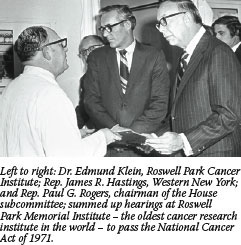 |
 December 23, 2006, marks the 35th anniversary of the passage of the NCA, a landmark statute that committed the United States' will and resources toward reducing the burden of cancer, and entrusted the leadership of that effort to NCI.
December 23, 2006, marks the 35th anniversary of the passage of the NCA, a landmark statute that committed the United States' will and resources toward reducing the burden of cancer, and entrusted the leadership of that effort to NCI.
The NCA was passed despite federal spending constraints, in a year when NCI's budget was less than $200 million. NCI Director Dr. Carl G. Baker had addressed a special Senate panel, chaired by Senator Ralph Yarborough (D-Tex.), earlier that year. The concerns he expressed, as well as the bold vision he laid out for the panel, were eventually encompassed in the NCA. This Act established a greater Executive Branch relationship with the National Cancer Program, converting the position of NCI director to a Presidential appointment and mandating that the NCI director administer the National Cancer Program with the advice of a President-appointed National Cancer Advisory Board (NCAB). In addition, the NCA authorized NCI to submit its annual budget request (the "bypass budget") directly to the President.
The NCA also established a three-member President's Cancer Panel (PCP) to monitor and evaluate the National Cancer Program through periodic public hearings and an annual progress report.
Finally, NCA established 15 new centers for clinical research, training, and demonstration of advanced diagnostic and treatment methods, and it positioned NCI to facilitate regional cancer control programs, in cooperation with the states and other health agencies. Around the same time that he signed the NCA, President Nixon converted the U.S. Army's germ warfare facilities at Frederick, Md., into a cancer research facility, which now houses part of NCI's Center for Cancer Research (CCR).
The NCA has been amended a number of times since 1971 to expand the authority of NCI, with a stronger emphasis on cancer control and research. NCI now has an annual budget of close to $4.8 billion, fueling programs that are among the most extensive and innovative in the world.
For example, NCA's original provisions for 15 Cancer Centers has grown into today's network of 61 nationwide. At these centers, as well as other institutions and on the NIH campus in Maryland, NCI has trained tens of thousands of people from the United States and abroad.
NCI has synergized cancer research worldwide through its Office of International Affairs, coordinating research consortia and conferences, and supporting research activities in more than 60 countries. The results in the last 35 years: NCI-sponsored research activities domestic and abroad have produced 227,000 published journal articles (as indexed in PubMed) - more than 10,000 this year alone.
Beyond basic and clinical research, NCI's extensive communication efforts are rooted in the NCA, which initially directed NCI to develop programs for rapid dissemination of cancer research to the international scientific community. This was later broadened to include cancer patients and their families, health professionals, and the public. Philanthropist and patient advocate Mary Lasker is credited with a major role in enacting the NCA, and her legacy is carried on today by the growing legions of patient advocate representatives actively involved in the National Cancer Plan through NCI's Office of Liaison Activities.
The fiscal challenges NCI is currently facing hearken back to the year that the NCA was signed. But NCI Director Dr. John E. Niederhuber has affirmed the institute's commitment to the legislation's original promise: "It is our responsibility to continually earn, and always merit, the public's trust," he said. "By investing in the three research spaces - the chemical, biological, and translational - and using powerful new technologies to integrate the discoveries from this investment, we will be able to generate better outcomes for all cancer patients and reduce the burden of cancer."
By Bill Robinson
|